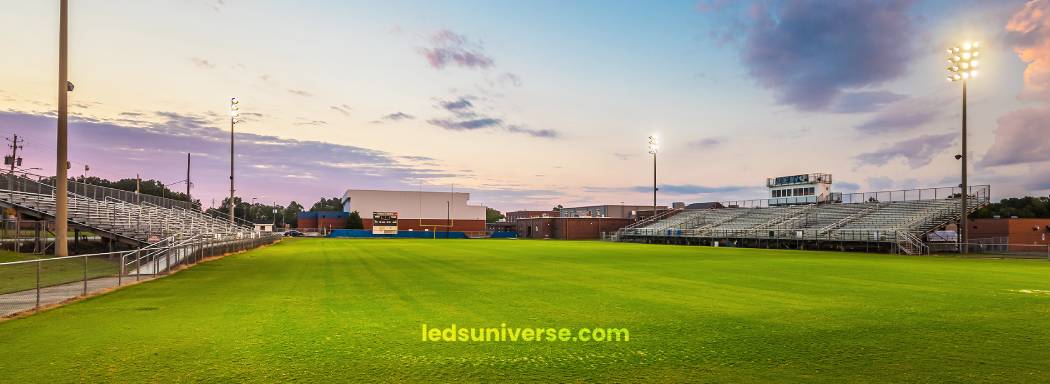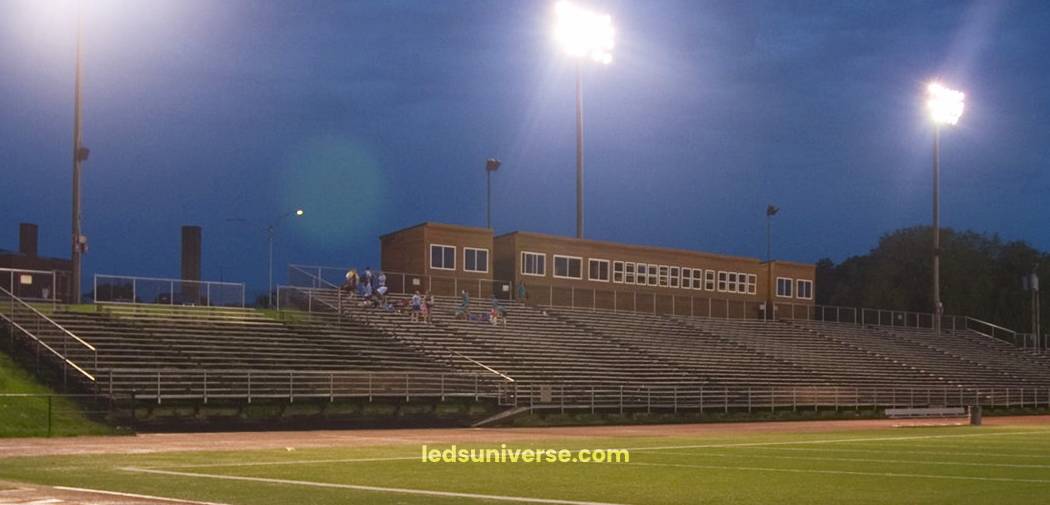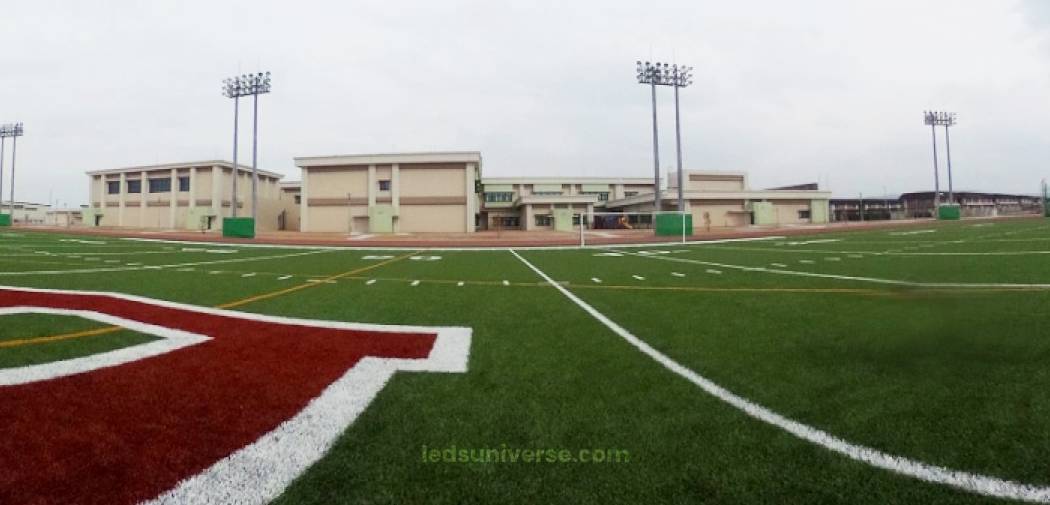The cost of installing modern lighting systems, especially energy-efficient LED solutions, can be a major hurdle for schools. Fortunately, a variety of grants are available from government programs, nonprofit organizations, and corporate sponsors, making these upgrades more attainable. With the right funding, schools can enhance both their athletic programs and community involvement, ensuring students have safe, well-lit spaces to compete and grow.
Well-lit sports fields can enhance athletic programs at high schools, allowing games and practices to continue after sunset. Lighting improves visibility and safety for both players and spectators, making night games a possibility. However, installing lighting systems can be a costly endeavor, leaving many schools unable to afford the necessary infrastructure upgrades. Fortunately, high school sports field lighting grants provide a way for schools to obtain funding to bring their fields up to modern standards.
Several organizations and entities, including government bodies, nonprofits, corporations, and private foundations, offer grants aimed at improving school facilities. These funding opportunities can make a big difference, particularly in areas where school budgets are limited. Schools seeking to improve their sports facilities can benefit greatly from researching and applying for the right grants to support field lighting projects.
Reach out for free lighting consultation
Table of Contents
Toggle| Type of Grant | Granting Organization/Source | Funding Range | Specific Conditions or Focus |
|---|---|---|---|
| Government Grants | USDA Community Facilities Direct Loan & Grant Program | $10,000 – $50,000+ | Rural schools; infrastructure improvements, including lighting. |
| State Government Programs | State and Local Government Initiatives | $5,000 – $100,000 | Energy-efficient lighting; may cover 30% to 50% of project costs. |
| State Departments of Education | Various State Programs | $20,000 – $200,000 | General school facility upgrades, including lighting for athletic fields. |
| Nonprofit and Foundation Grants | U.S. Soccer Foundation | Up to $100,000 | Sports-related facility improvements, including lighting. |
| USA Football | $2,000 – $50,000 | Facility lighting and infrastructure for youth football programs. | |
| The Kresge Foundation/Green Schools Network | $10,000 – $75,000 | Environmentally sustainable and energy-efficient lighting projects. | |
| Local Initiatives Support Corporation (LISC) | Up to $200,000 | Lighting upgrades in underserved communities; focus on expanding access to sports. | |
| Corporate and Private Sector Grants | Musco Lighting | $25,000 – $250,000 | Direct financial support or discounted lighting systems, often covering over 50% of costs. |
| Utility Companies | 20% – 40% of project cost | Rebates and grants for energy-saving LED lighting systems. | |
| Nike/Under Armour | $50,000 – $100,000 | Corporate sponsorships for facility lighting upgrades and youth sports programs. |

Government agencies often allocate substantial funds to support infrastructure projects at educational institutions, including high school sports field lighting. Schools can tap into federal programs, such as those administered by the United States Department of Agriculture (USDA), which provides grants through its Community Facilities Direct Loan & Grant Program. For example, rural schools can apply for grants that range from $10,000 to $50,000 or even more, depending on the scope of the project and the school’s specific needs.
Many states have specific initiatives to encourage the adoption of energy-efficient technologies, including LED lighting. Grants from these programs can cover up to 30% to 50% of the cost of installing such systems, making them much more affordable for schools. Some state-level programs offer grants starting at $5,000 and going up to $100,000, depending on the size of the project and the potential energy savings. For urban schools, there may be funding sources tailored to improving public spaces, including athletic fields, which are often integrated into larger community development projects.
Additionally, some state-level departments of education offer grants focused on general school facility upgrades, which include lighting for athletic fields. These funds can range from $20,000 to $200,000 depending on the school district’s size and the impact of the improvements.
Nonprofit organizations and educational foundations are supporters of high school sports field lighting projects, with grants often targeted at underserved schools. Nonprofit funding ranges widely, but some organizations, such as the U.S. Soccer Foundation, provide grants up to $100,000 for facility improvements. Similarly, USA Football’s grants for lighting and infrastructure projects can range from $2,000 to $50,000, depending on the school’s specific needs.
Grants from environmentally focused foundations often prioritize sustainability and energy efficiency. For example, The Kresge Foundation and The Green Schools National Network provide grants ranging from $10,000 to $75,000, specifically for projects that incorporate eco-friendly technologies like LED lighting. These grants often emphasize reducing energy consumption, so schools that design their lighting systems to minimize environmental impact may qualify for larger awards.
Some nonprofit organizations, such as the Local Initiatives Support Corporation (LISC), focus on expanding access to sports in underserved communities. LISC’s Sports and Recreation grants provide up to $200,000 for projects that include lighting upgrades, with the goal of enhancing the sports facilities of schools in economically disadvantaged areas.
Corporate and private sector grants are another source of funding for high school sports field lighting. Lighting manufacturers, such as Musco Lighting, often provide direct financial support or deeply discounted systems to schools that need upgraded lighting. For instance, Musco’s grants may cover 50% or more of a lighting project’s cost, with values ranging from $25,000 to $250,000 depending on the size and complexity of the installation.
Many utility companies offer rebates or grants to encourage schools to adopt energy-saving LED lighting systems. Rebates from utility companies can cover 20% to 40% of the project’s cost, depending on the projected energy savings. In some cases, grants of up to $100,000 are available to help cover installation costs. Collaboration between lighting manufacturers and utility companies often results in competitive pricing and rebates for schools upgrading their lighting systems.
Corporate sponsorships provide another avenue for funding. Companies with a vested interest in youth sports, such as Nike and Under Armour, offer grants that may provide as much as $50,000 to $100,000 for facility upgrades, including lighting. These sponsorships may also come with the added benefit of brand partnerships, which can further enhance a school’s athletic program and community engagement efforts.
Many grants are designed for schools and districts with limited financial resources. Eligibility may depend on factors such as the school’s budget, its ability to cover partial project costs, or the overall economic conditions of the area it serves. Grantmakers typically seek to fund projects that will have a meaningful impact on students in underserved communities, where budgetary constraints prevent schools from undertaking necessary facility upgrades.
Some grant programs may also focus on schools that prioritize sports as a key part of their educational mission. Schools with robust sports programs that lack the infrastructure to support evening games or practices due to inadequate lighting may have a stronger case for receiving financial assistance. Demonstrating how lighting improvements will directly benefit students can increase the likelihood of securing grant funds.

Certain grant programs focus on specific geographic areas, particularly when offered by government agencies or regional foundations. Rural schools, for example, may be eligible for funding through federal or state programs that aim to improve infrastructure in less populated areas. Similarly, urban schools in underserved communities might qualify for grants targeting inner-city development or youth engagement programs.
Programs offered by nonprofit organizations may also have geographic eligibility criteria. Some foundations focus on particular states, regions, or even cities. Local utility companies offering rebates or grants for energy-efficient projects may restrict eligibility to schools within their service areas.
Grants that promote sustainability often favor projects that prioritize energy-efficient solutions. Many organizations encourage the use of LED lighting in sports fields, as it is more energy-efficient and has a longer lifespan than traditional lighting systems. Schools that incorporate energy-saving technology into their lighting designs are more likely to be awarded grants from both government and private sector sources.
Some grants may even be tied specifically to environmental goals. Nonprofits and corporations with a focus on sustainability often provide funding for projects that reduce energy consumption or promote the use of eco-friendly technologies. Schools that demonstrate a commitment to these practices are often viewed as strong candidates for such grants.
In addition to technical and financial factors, many grantmakers look for projects that have broad community support. Schools with active booster clubs, parent-teacher organizations, or local business partnerships are often in a stronger position to secure grants. Demonstrating how a lighting project will benefit not just the school, but the wider community, can help make the case for funding. This could include showing how a well-lit field will allow for more evening events, such as community sports leagues, concerts, or other gatherings.
Schools that engage local stakeholders, from residents to small businesses, in the planning and execution of their projects may also be more successful in obtaining grants. Community support can be a critical factor in ensuring the long-term success and sustainability of a project.
In a rural area with limited resources, one high school faced challenges in maintaining its athletic program due to inadequate lighting. Evening games and practices were nearly impossible, causing a decline in participation and community engagement. The school applied for and secured a grant from the USDA Rural Development Program, which provides funding for infrastructure improvements in rural communities.
With the $50,000 grant, the school installed a new energy-efficient LED lighting system on its sports field. The upgrade allowed the school to extend field usage into the evening, accommodating more games and practices. As a result, the school experienced a 30% increase in sports participation. The new lighting system also drew larger crowds to evening games, fostering a renewed sense of pride in the school and its sports teams. The field quickly became a hub for community events, further integrating the school into local social life.
An urban high school with a strong sports tradition was struggling with outdated facilities and poor lighting. The school sought external funding and partnered with Musco Lighting, a company specializing in sports field illumination. Musco provided a sponsorship that covered 60% of the $250,000 installation cost for a state-of-the-art LED lighting system on the school’s football and soccer fields.
In exchange, Musco received branding opportunities at the school, including signage and recognition during sports events. The upgraded lighting allowed the school to host evening games, which improved game attendance by 40%. The partnership with Musco also led to additional sponsorships from local businesses, boosting funding for other parts of the athletic program. The lighting upgrade transformed the school’s athletic facilities, strengthened its connection to the local business community, and positioned it as a premier venue for local sports events.
A low-income high school with a struggling athletic program sought assistance to upgrade its sports field lighting. The school applied for a grant from the U.S. Soccer Foundation, which focuses on enhancing youth sports programs in underserved communities. The foundation awarded the school $100,000, fully covering the cost of installing energy-efficient LED lighting.
The new lighting system revitalized the school’s sports program, increasing participation by 35%. The school was able to host evening games for the first time, attracting larger crowds and increasing community engagement. Parents and local residents who had previously been unable to attend afternoon games due to work schedules were now able to support the teams. The improved facilities also helped the school secure additional donations and sponsorships for other projects, further strengthening the athletic department. This case illustrates the lasting impact that strategic grant funding can have on a school’s sports program and its broader community involvement.
A suburban high school, aiming to reduce energy consumption while upgrading its sports facilities, secured a state energy efficiency grant. The grant, valued at $75,000, covered 50% of the cost of installing an eco-friendly LED lighting system. The state’s initiative encouraged schools to adopt energy-saving technologies as part of its broader environmental goals.
With the new lighting system, the school reduced its energy consumption by 40%, which translated into annual savings of approximately $10,000 on electricity bills. The upgrade also allowed the school to host more events in the evenings, increasing the usage of its sports fields by 25%. The energy-efficient lighting not only provided cost savings but also aligned with the school’s environmental sustainability goals, enhancing its reputation as a leader in eco-friendly practices.
A high school in a small town faced budget constraints in upgrading its sports field lighting. The school applied for a grant from the local utility company, which offered rebates for energy-efficient projects. The utility company provided $50,000, covering 30% of the total project cost. The lighting manufacturer also offered a discount, further reducing the school’s expenses.
The combination of the grant and discounts allowed the school to complete the $150,000 lighting upgrade at a fraction of the cost. The new LED lighting system dramatically improved the quality of evening events, and the school saw a 20% increase in attendance at sports games. The utility company’s support also helped the school achieve significant energy savings, reducing its annual lighting costs by 35%.
These case studies illustrate how different types of grants and partnerships can significantly enhance high school sports facilities, benefiting not only the schools but also the surrounding communities.

Finding the right grants requires thorough research. Schools can begin by exploring federal and state grant programs through government websites, which often list funding opportunities for public school infrastructure projects. Nonprofit directories and corporate websites can also provide useful information on available grants. In some cases, contacting local utility companies or environmental organizations can reveal opportunities for funding energy-efficient lighting installations.
Networking can also be an effective strategy for identifying grant opportunities. Schools can work with local businesses, sports associations, and community organizations to find potential sources of funding.
A successful grant application requires careful planning and attention to detail. Schools should clearly outline the scope of the project, providing information on the current state of the athletic facilities and the specific upgrades needed. Applications should also include a detailed budget, outlining the costs of the lighting installation, maintenance, and any additional expenses related to the project.
It’s also useful to highlight how the project will benefit the school and community. This can include not only the immediate advantages of improved lighting but also the long-term benefits, such as energy savings, increased participation in sports, and enhanced community engagement. A well-crafted narrative that demonstrates the broader impact of the project can significantly strengthen an application.
An effective way to strengthen a grant application is to build strong partnerships and rally community support. Schools can engage local businesses, sports organizations, and civic groups to back the project. Letters of support from community leaders, local sports clubs, and parent-teacher organizations can bolster the school’s case for receiving funding. Demonstrating that the project has widespread community buy-in reassures grantmakers that the investment will have a lasting and positive impact.
Schools should also look for opportunities to create partnerships with local companies or national brands. Corporate sponsorships can be highly beneficial, especially if the company has an interest in youth development, sports, or energy efficiency. In exchange for financial support, companies may be willing to offer in-kind donations or services, such as discounted installation of lighting systems or ongoing maintenance.
Local sports leagues or recreational groups that use school facilities can also be key allies. These organizations may contribute to fundraising efforts or offer additional resources to support the lighting project. Schools that collaborate with external organizations can often build a stronger case by showing how the project benefits not only the school but also the surrounding community.
Another factor in the application process is timing. Many grants have strict deadlines, and missing these can mean waiting until the following year to apply again. Schools need to plan carefully, ensuring that all documentation and project details are completed well in advance. This includes gathering the necessary financial information, preparing a detailed project proposal, and securing any required endorsements or letters of support.
It’s also important to account for the time it will take to secure permits, address any zoning regulations, and prepare the field for the installation of lighting systems. Schools located in residential areas may need to navigate specific zoning rules or address concerns about light pollution. Early planning helps ensure that the project moves smoothly from application to installation without unnecessary delays.
After receiving a grant, schools are often required to provide progress updates or final reports detailing how the funds were used. This accountability is important for maintaining good relationships with grantmakers and ensuring eligibility for future funding opportunities. Schools should track the project’s expenses carefully and keep records of all work completed. Additionally, they should document the impact of the new lighting, such as improved participation in sports, increased community attendance at events, or energy savings resulting from the use of LED technology.
Grantmakers often value transparency and responsible use of funds, so providing detailed reports can be crucial for the success of future grant applications. Schools that demonstrate effective use of grant funds and clear communication with the granting organization will build a reputation as responsible grant recipients.
Sports field lighting grants offer schools a valuable opportunity to improve their athletic facilities and create safer, more accessible environments for students, athletes, and the community. By securing these grants, schools can extend the use of their fields, enabling night games, practices, and community events that foster school spirit and community involvement. Whether through government funding, corporate sponsorships, or nonprofit organizations, schools can find support to offset the costs of these projects. Thoughtful planning, strong partnerships, and a focus on energy-efficient solutions can ensure the long-term success of these lighting initiatives, enhancing both the athletic program and the broader school experience.